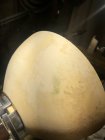I wonder what these discolorations are and what to do to remove or minimize them, if possible.
On this piece of horse chestnut there are two types of discolorations or stains, one is greenish and the other is a muddled brown. I have seen the muddled brown on other woods that I have recently turned, including on some ambrosia maple.

On this piece of horse chestnut there are two types of discolorations or stains, one is greenish and the other is a muddled brown. I have seen the muddled brown on other woods that I have recently turned, including on some ambrosia maple.

